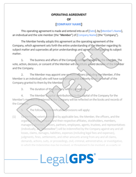How to Pass the 'Distinctive' Trademark Test: Examples and Tips
To register your trademark, it must be "distinctive" rather than generic. This means that it can't simply describe the product or service. For...
5 min read
LegalGPS : Oct. 14, 2024
Now that your trademark is registered, it's crucial to take steps to protect it. Trademark protection is an ongoing process that helps ensure your brand remains unique and legally enforceable. This guide provides several ways to effectively protect your trademark and maintain its strength over time.


Legal GPS Pro
Protect your business with our complete legal subscription service, designed by top startup attorneys.
One of the simplest ways to protect your trademark is by using the registered trademark symbol (®) next to your logo or brand name. This symbol informs the public that your trademark is registered with the United States Patent and Trademark Office (USPTO). It's a clear indicator that your brand is protected under federal law, and it deters others from using your mark without permission.
Difference between TM and ®: The TM symbol is used to indicate a trademark that has not yet been registered. Once your trademark is registered, you should switch to using the ® symbol to maximize protection. The ® symbol provides stronger legal rights and makes it clear that your trademark is federally registered, whereas the TM symbol only indicates a claim of ownership without federal registration.
Where to Use It: Place the ® symbol wherever your trademark appears—on your website, product packaging, promotional materials, advertisements, social media posts, and even email signatures. Consistent use of the ® symbol helps prevent others from claiming ignorance about your trademark rights.
Product Packaging: If your trademark appears on boxes, labels, or containers, ensure that the ® symbol is clearly displayed next to your brand name or logo. For example, if you sell a skincare line named "Glow Essentials®," the ® symbol should be on every bottle label and outer packaging.
Digital Media: Include the ® symbol on your website’s homepage, product descriptions, social media banners, and other digital assets. For instance, if you advertise your service under "TechSavvy Solutions®," make sure every online mention of the trademark includes the symbol.
Printed Materials: Ensure the ® symbol appears in brochures, business cards, flyers, and posters. For example, if you are promoting your new product at a trade show, make sure that your brand name, such as "Healthy Life®," is accompanied by the ® symbol in all printed advertising materials.
Merchandise: If you produce branded merchandise like t-shirts, hats, or tote bags, include the ® symbol next to your logo. This is especially important for businesses with a strong focus on branded goods, as it provides clear notice that the brand is protected.
Actionable Tip: Make it a habit to review all your marketing materials and communication channels to verify that the ® symbol is used correctly. Create a checklist that includes your website, social media accounts, packaging, and print materials to ensure consistency.
Convert Ideas Into Valuable Assets
To retain the exclusivity of your trademark, you must actively monitor and enforce its usage. This means continuously keeping an eye out for unauthorized use and taking appropriate action when necessary. Here are actionable steps to help you monitor your competition effectively:
Set Up Alerts: Use tools like Google Alerts, Mention, or Brand24 to receive notifications whenever your trademark or brand name is mentioned online. This will help you quickly identify potential misuse or infringement without manually searching.
Regular Trademark Searches: Perform regular trademark searches using the USPTO's Trademark Electronic Search System (TESS) and other trademark databases. This will help you identify if someone has applied for a similar mark or is trying to register a mark that may cause confusion with your brand.
Hire a Monitoring Service: Consider hiring a professional trademark monitoring service. These services use specialized tools and expertise to monitor trademark databases, online marketplaces, and domain registrations for unauthorized use. This proactive approach can save you time and ensure no infringement goes unnoticed.
Monitor Online Marketplaces: Frequently check online marketplaces like Amazon, eBay, and Etsy for counterfeit or unauthorized products using your trademark. Counterfeit products can damage your brand reputation and customer trust, so it’s crucial to address them swiftly.
Social Media and Digital Platforms: Regularly monitor social media channels and other digital platforms for unauthorized use of your brand. Tools like Hootsuite or Sprout Social can help you track mentions of your trademark across multiple social media networks. Look for fake accounts or unauthorized promotions that might be confusing your audience.
Monitor Industry Publications and Trade Shows: Keep an eye on industry publications, trade shows, and conferences. Competitors might use your mark in advertising materials, presentations, or product listings. If you notice any misuse, document it and take action immediately.
Check Domain Registrations: Regularly check domain registrations to ensure no one is using your trademark in a web address that could confuse customers. Websites like Whois.net can help you search for registered domains that might infringe on your trademark.
Actionable Tip: Create a dedicated calendar or spreadsheet to schedule regular monitoring activities. Consistency is key to protecting your trademark, and documenting your efforts can help in case of legal disputes.
Monitoring your trademark is crucial because failing to enforce your trademark rights can lead to dilution—weakening your brand's identity and making it harder to enforce your rights in the future.


Legal GPS Pro
Protect your business with our complete legal subscription service, designed by top startup attorneys.
If you discover someone using your trademark without permission, it’s important to act quickly. Here’s what you can do:
Document the Infringement: Take photos or screenshots of the unauthorized use, and make sure to include the date. Save copies of any web pages or advertisements where your mark appears without authorization.
Send a Cease and Desist Letter: A cease and desist letter is often the first step in stopping unauthorized use. This letter formally requests that the infringer stop using your trademark immediately. It’s advisable to consult with an attorney to draft this letter to ensure it covers all necessary legal points.
Consult an Attorney: If the unauthorized use continues after sending a cease and desist letter, you may need to hire an attorney to pursue legal action. Consider the following before proceeding:
Lost Business: How much lost business can you prove due to the infringement?
Infringer’s Ability to Pay: Is the infringer financially capable of covering damages? If they are insolvent, it may not be worth pursuing.
Cost of Litigation: Weigh the potential recovery against the costs of a lawsuit, including attorney fees.
Damages Calculation: Consider how to calculate other damages, such as harm to your brand reputation or loss of customer trust.
Taking prompt action not only helps you recover losses but also strengthens the legal protection of your trademark.
To keep your trademark active, you must maintain the required documents with the USPTO throughout the lifetime of your trademark. Here are the key filings to keep your trademark in good standing:
Filing Timeline: You need to file a Section 8 Affidavit between the fifth and sixth years after your trademark is registered. This affidavit confirms that you are still using your trademark in commerce.
Subsequent Filings: After the ninth year (but before the tenth), you need to file another Section 8 Affidavit along with a Section 9 Request for Renewal. This combined filing is required every ten years thereafter. For example, you will need to file these documents between years 19 and 20, 29 and 30, and so on.
How to File: You can find the necessary forms on the USPTO website. It’s important to file these documents on time to avoid cancellation of your trademark registration.
Maintaining these filings ensures your trademark remains valid and enforceable, and it demonstrates your ongoing use of the mark in commerce.
Protecting your trademark doesn’t stop with registration. Using the registered trademark symbol, monitoring for unauthorized use, taking swift action against infringement, and maintaining required documents with the USPTO are all essential steps to ensure your brand remains protected.
The biggest question now is, "Do I need a business lawyer?” For most businesses and in most cases, you don't need a lawyer to start your business. Instead, many business owners rely on Legal GPS Pro to help with legal issues.
Legal GPS Pro is your All-In-One Legal Toolkit for Businesses. Developed by top startup attorneys, Pro gives you access to 100+ expertly crafted templates including operating agreements, NDAs, and service agreements, and an interactive platform. All designed to protect your company and set it up for lasting success.

Legal GPS Pro
Protect your business with our complete legal subscription service, designed by top startup attorneys.

100+ legal templates, guides, and expert advice to protect your business.
Trusted by 1000+ businesses

To register your trademark, it must be "distinctive" rather than generic. This means that it can't simply describe the product or service. For...

Registering your company name as a trademark can be a significant step in protecting your brand. But is it always necessary? Let’s break down what...

If you've successfully filed a trademark application, congratulations—you've completed an important step in securing your brand. But to maintain your...